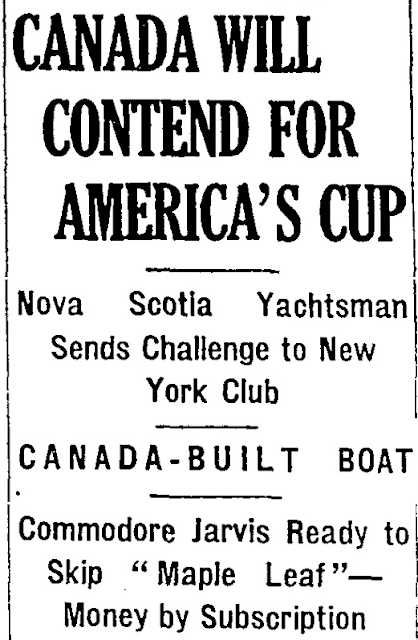Alexander C. Ross (1847-1921), Cape Breton M.P.
His father was the Rev. Hugh Ross, a prominent Presbyterian Minister who'd emigrated from Scotland to Nova Scotia as a child. Alexander's half-uncle on his mother Catherine's side, John Beaton, was the first to discover a coal seam in Inverness. (The Beatons were also Scottish emigres.) The property concerned was eventually sold within the family to Rev. Hugh along with two partners, and Alexander ultimately became involved in his father's ever-expanding business, reportedly the first outfit to conduct sub-marine coal mining in Cape Breton. [Montreal Gazette – Aug. 1, 1921]
 |
| Alexander Charles Ross [between 1881 and 1901]. (Photograph by Amos I. Rice. Rice Family fonds. MG 21.24 A.4. Beaton Institute, Cape Breton University.) |
As of 1881, A.C. Ross was a ship broker and salver, evidently a long-term career, working for Archibald & Co. and representing the venerable Lloyd's Insurance, most likely in relation to Lloyd's industry-standard ship registry (and/or their Salvage Arbitration Branch). This career made him well-suited to propose the building of a racing yacht to compete in the vaunted America's Cup, as he did in July 1920 (thereby kickstarting the process that lead to the Bluenose).
In the 1891 census he's listed as Superintendent of the North Sydney Electric Light Co. (which became part of the Cape Breton Electric Tramway & Power Co., formed in 1900, which in turn was renamed the Cape Breton Electric Co. in 1901).
 |
| Cape Breton Electric streetcar, Sydney, N.S. (undated). |
As per his Montreal Gazette obituary, Ross "for some years” owned the passenger steamer running between Sydney and North Sydney, and further was "for some years” the owner of the Sydney Hotel. He also owned a weekly newspaper called the Island Reporter in Baddeck, N.S., which he moved to Sydney to become the Sydney Daily Record, thereafter running the paper for many years as President.
 |
| Sydney Hotel, Sydney, N.S. (ca. 1900-1910) |
In the early 1890s, Ross organized a company which, after it floundered, was later taken up by rail magnates Sirs William Mackenzie and Donald Mann and rolled into their new Inverness Rail & Coal Co. (I.R. & C.) in the late 1890s. Much has been written about Cape Breton coal mining history, and the waters are thus muddied with varying accounts, however it seems almost certain that remnants of John Beaton's original concern, sold to Rev. Hugh Ross and ultimately known as the Broad Cove Coal Co., also made up part of Mackenzie and Mann's I.R. & C. (via interim owner, William Penn Hussey).
Recognizing the need to consolidate all the jumbled coal interests in his vicinity, A.C. Ross was one of the men credited with the idea for the establishment of the Dominion Coal Co., founded in 1893. |
| "Water Scene, St. John, N.B." (ca. 1908). Ship loading at Dominion Coal Co. dock in background. [Postcard via The Daily Postcard] |
In 1898, Ross began laying roots in Montreal, where he would ultimately make his home. Somewhere along the way he also lived in Halifax, and was for a period of time a member of Halifax's Royal Nova Scotia Yacht Squadron. He was also a charter member of Sydney's Royal Cape Breton Yacht Club, founded in 1899, and was an early Commodore of that club.
 |
| Royal Cape Breton Yacht Club (far right), Sydney N.S. (Sydney Hotel in background.) [From "Cape Breton, Canada, at the beginning of the twentieth century" (1903) by Charles Vernon.] |
On March 14, 1906, Ross won a by-election as the Liberal candidate in the riding of “North Sydney and Victoria” (better known as “North Cape Breton and Victoria”), serving under Prime Minister Sir Wilfrid Laurier until 1908. Upon taking his seat in the House of Commons in April 1906, introduced by Laurier, he was thus described in the Ottawa Journal: "The New Member is at once one of the striking figures of the Commons; tall, straight and dignified his appearance is imposing. His hair and moustache are silver grey, and his complexion ruddy.”
 |
| Alexander C. Ross, ca. 1906. |
Ross appeared on the fence as to whether to run again in the 1908 election due to policy differences with Laurier, namely regarding Maritime Intercolonial Railway running rights (ie. opening the federally-owned line for use by privately owned railway companies, which Laurier opposed), but the decision was ultimately made for him when he lost the Liberal nomination for his riding. Ross publicly broke with the Liberal party altogether in 1914 due primarily to the same policy issue, throwing his weight instead behind Prime Minister Sir Robert Borden's Conservatives. Borden's policy supporting running rights was seemingly beneficial to Ross' own business interests, it was accused at the time. Ross also disagreed with Laurier on Reciprocity (ie. Canada-U.S. free trade), which Laurier supported and Borden opposed.
 |
| "Intercolonial railway train elevator, Saint John, N.B." (undated). [Photo by William Topley via Library & Archives Canada] |
(In 1921, the Dominion Coal and Dominion Iron & Steel Cos merged with the Nova Scotia Steel Co. to create the British Empire Steel Corp. (BESCO), which in turn was re-constituted as the Dominion Steel & Coal Corp. (DOSCO) in 1928. DOSCO was one of the biggest private employers in Canada between the 1930s and 1950s.)
 |
| Halifax Herald - Aug. 2, 1920 |
 |
| Globe & Mail - Aug. 2, 1920. ("Nova Scotia Yachtsman" referred to is A.C. Ross.) |
Ross' America's Cup challenge was front page news right across the country. His proposal included building a schooner for the challenge, to be named “The Maple Leaf”. In The Globe at the time it was reported that, "Such a scheme as this is not a new idea of his, Mr. Ross stated, as the thought of having such a yacht has been in his mind for the past 30 years, ever since the "Thistle" was defeated." [The Globe – Aug. 3, 1920] (Thistle was a Scottish challenger for the America's Cup in 1887, explaining his affinity.)
On an Ottawa stopover, “attending to details in connection with the proposal to challenge,” it was noted that "Mr. Ross is well known in Ottawa, where he sat in Parliament. A quiet and vigorous personality, he belies the appellation of "sturdy sea dog" that some American papers conferred on him." [Ottawa Journal – Sept. 22, 1920]
His bid ultimately failed, falling far short of his $1 million fundraising goal due to his stubborn insistence on a public subscription method (capped at $100 per person), rather than accepting large amounts from numerous wealthy donors across the country who were eager to pony up. Halifax Herald publisher William H. Dennis' alternative Fishermen's Cup bid prevailed, and the rest is history. Work began on the legendary Bluenose in Dec. 1920, and Ross' Maple Leaf was never built.
A.C. Ross died on July 30, 1921, in Montreal, two months before the Bluenose he helped inspire ran her first race.
Written by Ashley Newall
Full story of A.C. Ross' America's Cup challenge here: Did a Canadian Challenge for America's Cup Spawn the Bluenose?: A.C. Ross and the never-built schooner, “Maple Leaf”
My Cape Breton Post/Saltwire article on Ross' America's Cup Challenge here: "Cape Breton connection: How an Inverness MP played a pivotal role in the plan that launched the Bluenose"


%20from%20Government%20Hill,%201855.jpg)

,%201829-1900%20-%20banner.jpg)
